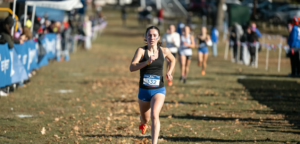 By Duane Ford
By Duane Ford
I consider myself to be a pretty knowledgeable and passionate sports fan. This spring sports season two of my sons have begun playing sports that I have no idea about the rules, why things are done in certain ways and a host of other items that make me feel out of my element.
Case in point, my youngest son is running track for a great organization, the NH Thunder. We went to our first practice and it was really well run, tons of adult volunteers who are passionate about the sport and made kids of all abilities and experience feel accepted and welcome.
I am a public school assistant superintendent by profession, so as part of my job I go to a lot of high school sporting events and love it immensely. I have been to several track meets over the years and there are several things that I do not understand from the world of track and field. Here are 10 that I would love to get New Hampshire Track and Field to give me some understanding on…
- Why can an athlete only compete in four events? I would think that you should be able to participate in as many things as you can. Isn’t that good for the team?
- What is up with the pole vault? I get the rest of the events, run the fastest, jump the highest or farthest, throw something a long way but this one baffles me. Take a long pole and stick it in the ground and go over another pole the is up in the air. Where did this come from?
- Speaking of the pole vault, shouldn’t they be wearing helmets? That is a long way up in the air and therefore a long way down. Helmets please!
- There seems to be a lot of rules for the relay events. If you drop the baton are you disqualified? In or out of the pass-the-baton area (pretty technical term there) and there are things that happen including being disqualified. That seems pretty harsh.
- Another relay question…why are there four runners in the relay? Why not two or three or six?
- How come only the top six finishers score points? I think the top ten makes sense. That seems like a good cut off, you made the top 10! What other sport rewards the top six?
- Who picks the order of the events? It seems that at the state meet, they are in the same order every year. Let’s mix it up, have the coaches get to pick the order, lots of strategy potential.
 Do the coaches know what the score is during a track meet? I have no idea what the score is or how various teams are doing. Where is the scoreboard?
Do the coaches know what the score is during a track meet? I have no idea what the score is or how various teams are doing. Where is the scoreboard?- Why is the track itself made out of asphalt, concrete or whatever that is? Even with the rubberized top, it is really hard. How about a nice grass track?
- Why do the throwers have to throw whatever they are throwing into a certain area? If you don’t throw it straight, it does not go as far and that should be your punishment for non-accuracy. I also used the word throw three times in the same sentence, which is awesome.
Thanks for your answers…love the website.












4 Responses
A scoreboard would be awesome! Especially at the state meet.
100% agree! Will say at the state championships scores are updated after each event on the live results feed on Lancertiming. We can look into ways to make this easier to see on the livestreams as well. Onward and upward!
I have practiced on a grass track and watched a collegiate 800m while on a trip to Ireland. Whoooo no. Hundred thousand ankle injuries waiting to happen and sloooooooow.
re: throwing direction – I imagine for safety! If the athlete has no idea where it is going, sure no one else does! Imagine the poor officials for the discus or weight/hammer throws . . .
Hi,
I know this is an old thread but the questions are still valid so here are some answers.
1: There are a number of reasons why there is a limit on number of events in high school, the most important being to prevent athletes being run to exhaustion. More to your point, while it may be good for the team to have one athlete in seven events where they can score, competing in multiple events in one day is an incredibly taxing undertaking even for the most elite athletes. The risk of injury increases dramatically as an athlete tires, and all events, be they running, jumping or throwing, require an athlete to perform at their absolute maximum effort over the course of the event, so tiring is inevitable. another reason why there is a limit on events is to allow meets to be held in a single day. there are many different events that occur simultaneously at every meet and athletes must balance their time to be at each event when it is scheduled for competition. I speak from experience saying that it is hard enough trying to manage three simultaneous events that occur on different ends of the track! In college and beyond there is no cap for events (unless stated by the meet director) and athletes and coaches are expected to manage their work load appropriately. At some meets if you do not make an attempt at your scheduled event at the time you will simply forfeit your attempt at that event or in a field event the official may choose to move your attempt to later in the order. In other, generally larger meets, there is something called a scratch rule, where failing to report to your event on time disqualifies you from all events held at that meet.
2:Pole vault originated as a practical means of avoiding obstacles such as canals in places like the Netherlands where such structures are common even today. Canal jumping is still a sport in these places and is actually pretty fun to watch! Its not too difficult to imagine pole vault being applied to scaling large walls which were too tall to efficiently jump over otherwise. Similar to running, jumping, throwing, and even competitive lumber jacking, this practical skill was turned into a competition, and another way to compare human abilities.
3:Pole vault is one of the scariest sports to watch in my opinion. some schools make their athletes were helmets while vaulting, as do some states as well. The two times that a helmet will be helpful are when your head hits the ground and when your head hits the standard. Neither of those are things that happen frequently, although they do happen more than many like to think about. It is very unlikely (in my opinion, I have no data to support this) that you are going to have a good enough plant to get very high up in the air and somehow not have the correct momentum to carry you into the pit to safety. It seems far more likely (again I am going entirely based of anecdotal evidence) that you will be able to get yourself in position where your head is in danger of contacting a hard surface off of a botched plant where you do not release the pole form your hand and your feet are swung out from underneath you. This can be prevented by a competent coach who takes the time to train their athletes on how to safely handle this situation. The most likely injury to occur (at least in my experience) is an athlete achieving a decent height and falling into the pit onto their neck, straining or more seriously injuring their neck. This isn’t something that a helmet will help with and may actually make worse due to the added leverage from the helmet. Again this is an issue which, with adequate coaching, should never arise. The most frequent injury i have seen occur from the pole vault has actually been catastrophic knee injuries. These happen when an athlete has enough speed to reach the highest height of their pole, but not enough to make it into the pit. The athlete invariably bails out on the jump and will fall into the plant box from height and severely injure their knees on impact. This is, again, easily prevented by adequate coaching and awareness by the athlete. So all in all, should pole vaulters wear helmets? Maybe, but at the very least they should have a coach who knows what they are talking about!
4: There are actually not as many rules in a relay as you might think. There are four runners, they must pass the baton within the exchange zones, and one team cannot interfere with another. Those are the only rules that are specific to relays. The normal rules about lanes and starts still apply. A team can indeed drop the baton, pick it up and successfully complete a race, provided they do not break any other rules. For example, a team can drop the baton during an exchange and, provided they do not interfere with another team, retrieve it, return to their lane, and continue the race to completion. The interpretation of these rules is as always subject to the will of the officials running the meet.
5:The simple answer is because that’s how it is? There has to be some standard that is kept and this is the one that was chosen for championship meets. I have competed in meets where there are three people in a hurdles shuttle race which was very interesting, at certain dual meets in college we had a race where every eligible and capable runner on each team ran and the average pace for your team determined your overall placing even! So relays can really be whatever you want to make of them, but for championships and records a standard was chosen and that happens to be four runners.
6:That is actually not true universally. Some meets don’t even keep score, some small meets only score the top three places, others only score the top two performances from each team. At larger meets it is not uncommon to find the top 8 places score. Generally the number of scoring places is decided by the number of lanes in the full track. This is because the number of lanes in the full track is the maximum size of a finals heat in the 200 and 400. The NHIAA has its own rules about the scoring of championship meets which are available on their website.
7: The order of events is set by the meet director most times and different meet directors have different preferences for how to run a meet. some have a way that they have found which is most efficient and they swear by it. Some are very forgiving in the way they organize the events. There is already a huge amount of strategy that teams in contention for a state championship use when deciding which athletes will run which events and which athletes will be scratched at the seeding meeting as well as who to run in their relays and which ones to save for individual events. Its a great pass time to try and predict how a certain meet will end up scored out based off of the Battlenotes!
8: Results at the state meet are all posted on the timing services page and are likely published at the meet after each event has been scored. There is always the old fashion way of keeping track of finishes in each event on a not pad and hand tallying it! But a live score board would certainly make it simpler to keep up!
9: Rubberized tracks are simply faster than grass because of the same reasons that a ball will roll farther on an artificial turf than on a full grass field. The surface of a track is uniform and firm with some shock absorption built in to protect runners from the high impact forces seen during running and jumping. Grass is notoriously difficult to maintain to the same uniform surface and is likely to cause injury due to this. Grass is definitely a good cushion, in fact it is too good a cushion to be fast. When a runners foot strikes grass, some of the energy they are producing goes into deforming the surface. The dirt also has a tendency to break up under the high load a runner accelerating out of blocks produces. With a rubber track (if your child is ever made to train or compete on an asphalt track with no rubberization take them home for the sake of their shins!!!) there is more efficient force transfer, you are more likely to push yourself forward instead of pushing the dirt backward. The grass blades themselves can also cause significant drag on the foot of a runner if it is not kept short, which will decrease the performance of the athlete. If you don’t believe this then I ask you to consider why track spike manufactures would bother to design ultra light and aerodynamic shoes if there wasn’t a legitimate need for them!
10: As a former multi turned thrower by injury I share your excitement in getting to talk about throwing a lot! The sector on the throwing field is not meant so much to constrain the thrower, although it does do that, as it is to give the thrower a safe location to perform their throw! That’s the thing about throwers see, we are going to throw things anyway, why not give us a safe place to do it where we aren’t going to hurt anyone! All joking aside throwing really is dangerous. It’s one of the safest events for the athlete and one of the most dangerous events for the spectators and officials. The confines of the sector are there to not only give a target to the thrower but to define a danger zone for the rest of the world. Even in the discus, I have managed to hit a person who was nowhere near the sector and was well behind the safety net. If you are going to spend time near any throws, please be careful. Another more historical reason that there is a throws sector is the origin of the events themselves. All of the throws were born as mechanisms of war. The javelin and discus are great examples of this as they were used in the first Olympic games, a tradition which found its roots in testing the skills of soldiers. Javelin in the ancient Olympics had two subdivisions, the first was very similar to the javelin of today and was intended to measure the maximum distance that a soldier could throw a spear. The second part was an accuracy test because what good is a 100m javelin throw if you cant hit anything! These two disciplines would eventually combine into what we know today as the competitive javelin throw. The same is true for the discus and hammer throws. The shot put got its origins from the highland traditions on display in Braveheart. It was essentially a who can throw this rock the furthest in that general direction.
Hope that helps someone, I know I was a few years late with the reply!